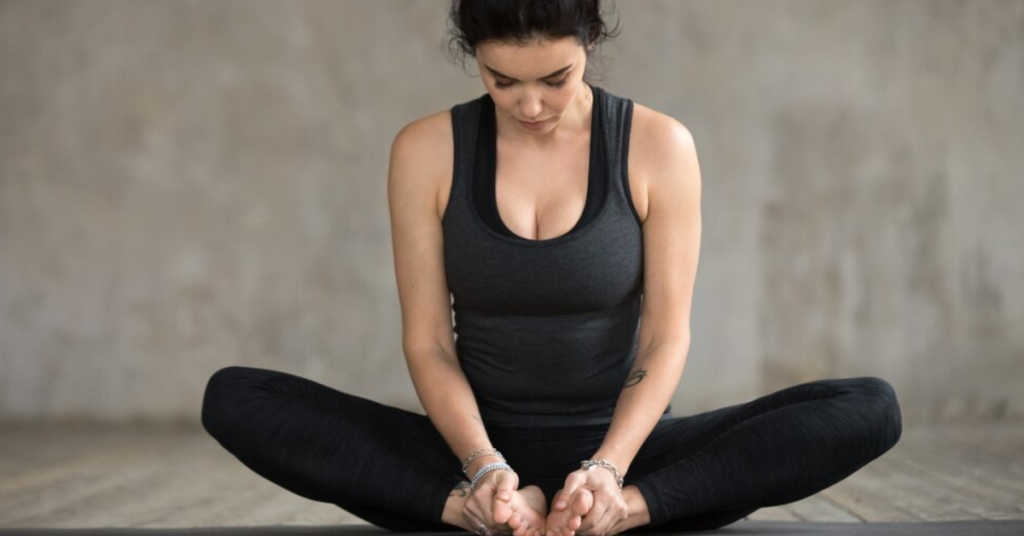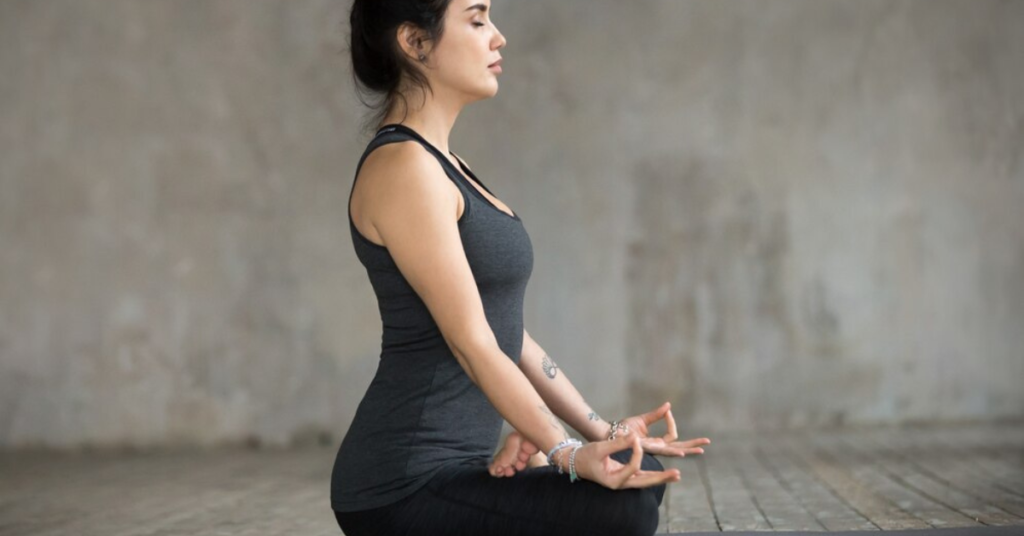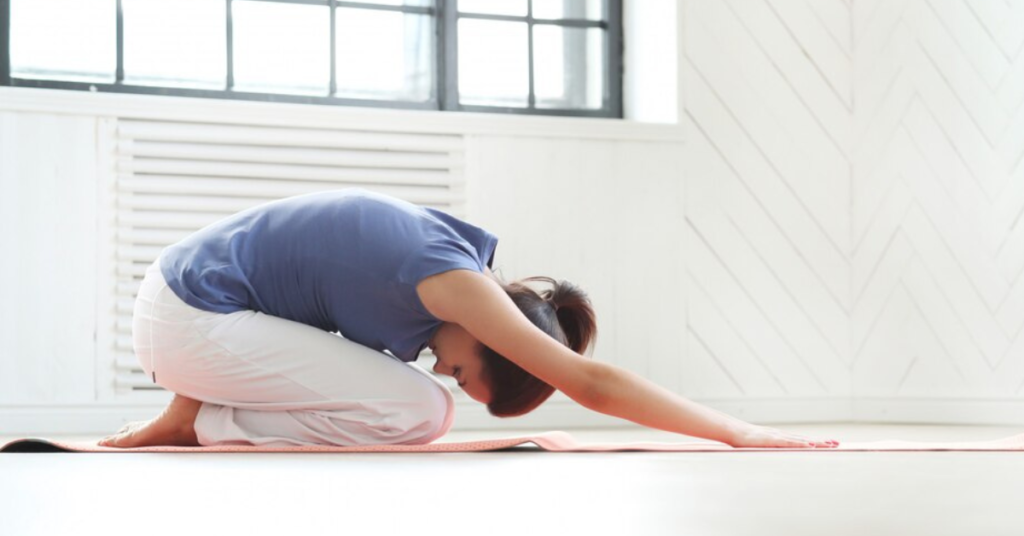PCOD, which stands for Polycystic Ovarian Disease, is a medical condition where a woman’s ovaries produce an excessive number of immature or partially mature eggs. Over time, these eggs can develop into cysts within the ovaries. As a result, the ovaries can become enlarged and produce elevated levels of male hormones, known as androgens. This hormonal imbalance can lead to various issues such as infertility, irregular menstrual cycles, hair loss, and abnormal weight gain.
In this detailed guide, we will explore 5 powerful yoga poses that can effectively ease PCOD symptoms, such as reducing stress, balancing hormones, and enhancing overall well-being.
1. Bhadrasana (Butterfly Pose):
Bhadrasana, derived from the words “Bhadra” meaning firm or auspicious, is often referred to as the firm or auspicious posture. It serves as an excellent meditation pose and promotes increased blood flow in the pelvic region.

To perform the Bhadrasana yoga pose, follow these steps:
- Start by sitting on the floor with your legs extended straight in front of you.
- Take a few deep breaths to relax and prepare yourself.
- Bend your knees and bring your heels as close to your pelvis as possible.
- Hold your feet with your hands and gently pull them closer to your groin area. Your soles should be touching each other.
- Sit up straight with your spine erect and your shoulders relaxed.
- Place your hands on your knees, palms facing down.
- Close your eyes and take deep, slow breaths. Focus on your breath and relax in this position.
- Hold the pose for as long as it’s comfortable, aiming to gradually increase your time in the pose with practice.
- To release, gently straighten your legs and return to a seated position with your legs extended.
Benefits:
- Bhadrasana is excellent for stretching and opening the hips and groins.
- It improves pelvic circulation, which can help regulate menstrual cycles and reduce menstrual cramps.
- This pose also releases stress and tension in the body, a significant benefit for PCOD patients.
2. Baddha Konasana (Bound Angle Pose):
Baddha Konasana, commonly referred to as the Bound Angle Pose or Cobbler’s Pose, is a versatile yoga position known for its benefits in hip opening and inner thigh muscle stretching. Despite its apparent simplicity, this pose offers advantages like strengthening the core muscles and enhancing posture.
Additionally, practicing Baddha Konasana engages the back muscles as you elongate and stretch your spine, emphasizing the importance of a strong and stable core for this posture.

Here are the steps to perform the pose:
- Start in the Staff Pose, sitting with your spine tall and directly on your sitting bones, not slouching backward.
- Bend your knees and allow them to open outwards to the sides.
- Bring the soles of your feet together, and use your hands to gently open them, like you would open the pages of a book.
- Press your shoulder blades against your upper back to lift your chest and sternum. You can hold onto your ankles to assist in lifting your upper body.
- To come out of the pose, gently release your feet and return to the Staff Pose.
Benefits:
- Baddha Konasana helps regulate thyroid glands and balance hormones.
- It aids in digestion and relieves constipation, which can be symptoms of PCOD.
- This asana also provides relief from stress and anxiety, which can exacerbate PCOD symptoms.
3. Paschimottanasana (Seated Forward Bend):
The term ‘paschim,’ which translates to ‘west,’ is employed to describe the back or posterior of the body. ‘Uttana’ signifies stretching. It’s clear that maintaining a healthy spine is essential. Engaging in the practice of this asana and achieving its final posture also instills a sense of accomplishment along with humility.

Here’s how to perform this yoga pose:
- Start in Dandasana (Staff Pose) with your sitting bones pressing into the floor or a prop, and engage your lower belly by drawing it in and upwards.
- Inhale and lengthen your spine, keeping it straight and tall.
- As you exhale, initiate the forward fold by hinging at your hips. Be cautious not to round your back; maintain a straight spine throughout.
- While folding forward, focus on maintaining length in the front of your body, initiating the movement from your belly, then through your ribcage, chest, and finally bringing your forehead toward your legs.
- Allow your arms to slide down along the floor. If your hands can reach your feet, grasp your big toes with your first two fingers and thumbs. Bend your elbows, keeping them lifted away from the floor and out to the sides. Ensure your shoulders remain relaxed, away from your ears. If you can’t reach your feet, use a strap around the soles of your feet, holding it with both hands and keeping your arms straight.
- To deepen the stretch, with each inhale, elongate the front of your torso and slightly lift your head. With each exhale, attempt to fold deeper into the pose, all while maintaining a long spine and hinging from your hips. Keep your neck in line with your spine. If you’re using a strap, gradually walk your hands down the strap as you deepen the stretch, always keeping your arms straight.
Benefits:
- Paschimottanasana stretches the spine, hamstrings, and lower back, reducing back pain and discomfort often associated with PCOD.
- It stimulates the ovaries and promotes hormonal balance.
4. Ardha Matsyendrasana (Half Lord of the Fishes Pose):
The term “Ardha Matsyendrasana” originates from Sanskrit and means “Half Lord of the Fishes Pose.” Ardha Matsyendrasana Yoga is a seated twisting pose that is beneficial for enhancing posture and rejuvenating the digestive system.

If you’re curious about how to perform Ardha Matsyendrasana, this guide is here to help!
- Begin by sitting comfortably on your yoga mat with your legs crossed.
- Place your right hand on your left knee and gently twist your upper body to the left side.
- Focus on initiating the twist from the base of your spine and continue it through your shoulders.
- Ensure that you keep your body firmly grounded on the mat, and be cautious not to strain your lower back while stretching.
- Your left hand should be positioned on the mat just behind your hips to support your twist.
- Untwist and then repeat the same exercise on the other side.
- It’s important to perform Ardha Matsyendrasana slowly and mindfully, as rapid movements can potentially strain your neck or lower back.
Benefits:
- Ardha Matsyendrasana stimulates the liver and kidneys, aiding in detoxification and improving liver function – essential for hormonal balance.
- This pose also stretches the shoulder, hips, and spine, relieving tension and discomfort.
5. Balasana (Child’s Pose):
Balasana, commonly known as Child’s Pose, is a yoga posture celebrated for its soothing, grounding, and tranquilizing properties. This gentle pose offers a subtle stretch to the lower back, hips, and thighs, simultaneously promoting mental calmness and stress relief. It’s not just a perfect interlude during a more dynamic yoga session; it also contributes to enhancing posture, alleviating discomfort, and fostering overall well-being.

Here are the steps to perform this yoga pose:
- Begin in the Table pose. Exhale and lower your hips back toward your heels, bringing your forehead to the floor. You can keep your knees together, or if it’s more comfortable, slightly spread them apart.
- You have options for your arm placement:
- Extend your arms overhead with your palms resting on the floor.
- Stack your palms or make fists to support your forehead.
- Keep your arms alongside your body with your palms facing upward.
- Take slow and deep breaths, actively pressing your belly against your thighs as you inhale.
- Hold this position and continue to breathe deeply for 4 to 12 breaths.
- To release from the pose, place your palms under your shoulders, and slowly inhale as you lift yourself up to a seated position.
Benefits:
- Balasana improves blood flow to the reproductive organs, enhancing overall reproductive health.
- It is a great way to release stress and anxiety, which can have detrimental effects on PCOD.
Conclusion:
By incorporating these five yoga poses into your daily routine, you can experience a significant difference in managing PCOD symptoms. These poses offer a holistic approach to addressing hormonal imbalances, improving digestion, reducing pain, and alleviating stress and anxiety. Commit to regular practice, and you can embark on a journey towards better PCOD management and overall well-being. Yoga provides a natural and empowering path to reclaim control over your health and lead a fulfilling life. Start today and experience the transformative benefits of yoga for PCOD management.
Disclaimer: The content provided in this blog is for informational purposes only. Consult with a qualified yoga instructor or healthcare professional before attempting any yoga practices or exercises mentioned. Your health and safety are of utmost importance.




